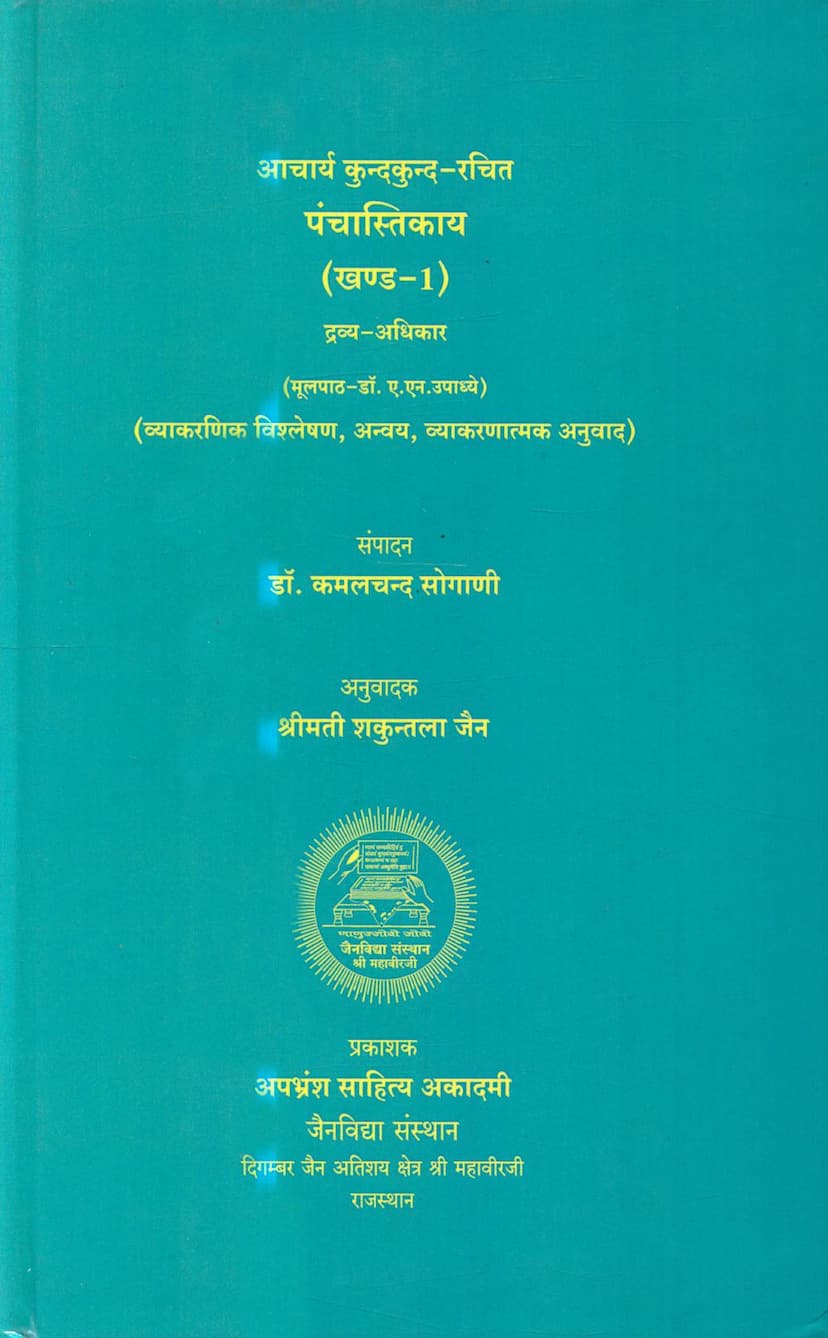Panchastikay Part 01
Added to library: September 2, 2025

Summary
This document is the first volume of "Panchastikay" (Panchastikaya) by Acharya Kundkund, specifically focusing on the "Dravya Adhikara" (Chapter on Substances).
Here's a comprehensive summary of its content:
Book Details:
- Title: Panchastikay Part 01 (Dravya Adhikara)
- Author: Acharya Kundkund (Original text)
- Edited by: Dr. Kamalchand Sogani
- Translated by: Smt. Shakuntala Jain
- Publisher: Apbhramsa Sahitya Academy, Jainvidya Sansthan, Shri Mahavirji, Rajasthan
- Catalog Link: https://jainqq.org/explore/002306/1
Key Content and Themes:
The book is a detailed exposition of the fundamental principles of Jain philosophy, particularly the nature of reality as explained through the concept of "Panchastikaya" (Five Existences) and "Dravya" (Substance).
- Introduction to Acharya Kundkund: The preface highlights Acharya Kundkund as a significant figure in Jain literature, dating back to the first century CE. His important works include Samaysara, Pravachansara, Panchastikaya, Niyamsara, etc.
- Structure of Panchastikaya: The text mentions that Panchastikaya is composed in Sauraseni Prakrit. This particular volume (Part 1) covers the "Dravya Adhikara" which includes verses 1 to 96 of the original text. The second part, "Nav Padartha Adhikara," contains verses 105 to 153. Verses 97 to 104 are attributed to Acharya Jayasen and are not included in this translation.
- Dravya Adhikara Focus: This chapter meticulously explains the concept of "Dravya" (substance) and its fundamental characteristics.
- Dravya and Existence (Satta): It clarifies that "Dravya" is synonymous with existence. Dravyas are eternal, neither created nor destroyed, but they possess qualities and modifications (Paryayas).
- Dravya, Guna, and Paryaya: The text elaborates on the relationship between Dravya (substance), Guna (quality), and Paryaya (modification/state). It emphasizes that Dravya is the substratum for Gunas and Paryayas. Paryayas are subject to origination and cessation, while the Dravya itself remains eternal. The relationship between Dravya and Guna is described as inseparable, like knowledge and the knower, rather than distinct entities.
- The Five Astikayas (Existences): The core of the "Dravya Adhikara" is the description of the five Astikayas (substances that have extension, i.e., occupy space) and their characteristics. These are:
- Jiva (Soul): Described as conscious, possessing knowledge and perception, capable of self-upliftment, the doer and experiencer, and though immeasurable in nature, it is embodied. The liberated soul (Siddha) is free from karmic impurities and experiences infinite bliss.
- Pudgala (Matter): Exists in the form of atoms and aggregates (Skandhas). Pudgala is described as having one color, one taste, one smell, and two types of touch. It is the cause of sound when formed into aggregates.
- Dharma (Motion Principle): An essential substance that facilitates movement for souls and matter. It is compared to water helping fish to swim.
- Adharma (Stationary Principle): A substance that provides rest to souls and matter, enabling them to remain in place. It's likened to the earth providing rest to a traveler.
- Akasha (Space): The substance that provides space for all other substances. It is divided into Lokakasha (occupied space within the world) and Alokakasha (unoccupied space beyond the world).
- Kala (Time): While not an Astikaya (as it is not multidimensional), Time is also discussed as a Dravya that facilitates modifications in other substances. It is eternal and independent, while its modifications (like moments, days, years) are dependent and perishable.
- Grammatical Analysis and Glossary: The book includes a detailed grammatical analysis of the Prakrit verses, explaining the meaning and function of each word. It also provides extensive glossaries (Sanskrit-Prakrit) for nouns, verbs, participles, adjectives, pronouns, and indeclinables, making the text accessible for those studying Prakrit and Jain philosophy.
- Key Concepts Explained:
- Dravya (Substance): Eternal, unchanging essence with numerous qualities and states.
- Guna (Quality): Inherent characteristics of a Dravya that are inseparable from it.
- Paryaya (Modification/State): Temporary changes or states that a Dravya undergoes.
- Astikaya: Substances that have extension and occupy space (Jiva, Pudgala, Dharma, Adharma, Akasha).
- Anu (Atom): The fundamental, indivisible particle of Pudgala.
- Skandha (Aggregate): A combination of atoms.
- Anekanta: The doctrine of manifold aspects or relativity, which is crucial for understanding reality.
- Syadvada: The doctrine of "perhaps" or conditional predication, which expresses the multifaceted nature of reality.
Overall Purpose and Audience:
This volume is designed to be a scholarly and accessible guide to the foundational ontological principles of Jainism. It caters to students and scholars of Jain philosophy, Prakrit language, and Indian classical texts. The detailed grammatical analysis and translation aim to facilitate a deep understanding of Acharya Kundkund's profound teachings on the nature of reality.